Since 2019, we have been reflecting on aspects of environmental cleaning in healthcare, stimulated by colleagues. We believed it was necessary to raise the profile of this important topic, particularly with regards to strategic approaches to integration and improvement.
Hygiene and cleanliness provide dignity and are a sign of respect to those who are seeking care and facilitate the work of those delivering it. It is that important.
We have history in this area. In 2005, the World Health Organization’s (WHO) First Global Patient Safety Challenge was launched, with our involvement, and it wasn’t just about hand hygiene! It included considerations on clean water, clean equipment and clean practices.
So, in 2021, we published a commentary, focused on data, norms standards and guidance, advocacy, funding and research, and recommending action to enhance environmental cleaning.
In 2020, we were contracted by WHO to produce the first ever global training package on environmental cleaning. This package aims to improve the competence of those who clean. It uses a participatory approach targeted at adult learners. It compliments existing resources that aim to improve infection prevention and control (IPC) and hygiene overall, necessary to support training on cleaning and to be sure it can take place reliably. It is accompanied by modules and resources, short videos, a WHO OpenWHO course and a research evaluation protocol.
We were then delighted to the join colleagues to undertake two additional pieces of work to raise the profile.
First, a CLEAN BRIEFING research priorities paper, which highlights a range of aspects: Cleaning Standards: What are the human resource requirements to achieve microbiological cleanliness in different types of healthcare settings?; System strengthening: What are the health system-level factors that can support the professionalisation of cleaning staff?; Behaviour change: What are cost-effective strategies to maintain the required frequency and quality of cleaning in a healthcare setting?; Innovation: Are locally produced disinfectants more cost-effective compared to existing commercially available disinfectants?

Secondly, a commentary focused on Environmental cleaning barriers and mitigation measures identified through two initiatives in four countries, 2018–2023.
Throughout this time, we have raised questions, stimulated by the literature, such as Why are those who clean our health facilities not paid the same as a senior manager? Within the context of IPC, WHO describe cleaning staff as an important part of the workforce and highlight this group as a target for training, given their role in overall health service delivery.
We are now undertaking work to look at an approach to multimodal improvement strategies for countries undertaking baseline assessments on environmental cleaning.
But what can others do with regards to both and enhancing practices in all settings going forward? Consider the following:
- How can we motivate countries to collect more and better data related to water, cleaning and overall hygiene? How can we stimulate different programmes to join forces to address the data gaps?
- How can we ensure the multitude of guidelines and standards are implemented?
- What about renewed, cross-discipline, cross-programme dissemination strategies?
- What sort of teaching, visualization and checking are you using the improve environmental cleaning?
- How can we maximise the impact of all of the resolutions, campaigns and calls to action across the world?What about combining advocacy efforts – a campaign of campaigns?
- Would greater integration and collaboration amongst organizations committed to IPC, WASH and AMR, including NGOs support this? This links with WHO’s Global Action Plan and Monitoring Framework on IPC, published in 2024.
- How can we unite around the research priorities in the CLEAN Briefing Paper & advocate for its recommendations?
- What are the reference points that guide your work e.g. guidance, data, campaigns, research priorities?
